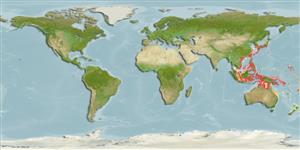Environment: milieu / climate zone / depth range / distribution range
Ecología
marino asociado a arrecife; no migratorio; rango de profundidad 10 - 40 m (Ref. 48391). Tropical
Western Pacific: Japan to the northern Philippines.
Tamaño / Peso / Age
Maturity: Lm ? range ? - ? cm
Max length : 12.0 cm NG macho / no sexado; (Ref. 47838)
Espinas dorsales (total) : 14; Radios blandos dorsales (total) : 16; Espinas anales: 3; Radios blandos anales: 15.
Inhabits steep outer reef slopes (Ref. 9710); in ledges and caves (Ref. 48391). A shy species, not easily approached at close range (Ref. 4537). Usually observed singly, almost always upside down in reef caves (Ref. 47838); also forms pairs or small groups (Ref. 48391). Natural diet unknown (Ref. 48391). Sometimes forms hybrids with Centropyge multifasciata (Ref. 48391). Occasionally exported through the aquarium trade.
Life cycle and mating behavior
Maturities | Reproducción | Spawnings | Egg(s) | Fecundities | Larva
Pyle, R., 2001. Pomacanthidae: Angelfishes. p. 3266-3286. In K.E. Carpenter and V.H. Niem (eds.) FAO species identification guide for fishery purposes. The living marine resources of the Western Central Pacific. Volume 5. Bony fishes part 3 (Menidae to Pomacentridae). Rome, FAO. (Ref. 48391)
IUCN Red List Status (Ref. 130435)
Threat to humans
Harmless
Human uses
Pesquerías: comercial; Acuario: Comercial
Herramientas
Special reports
Download XML
Fuentes de Internet
Estimates based on models
Preferred temperature (Ref.
123201): 21.3 - 29, mean 27.8 °C (based on 212 cells).
Phylogenetic diversity index (Ref.
82804): PD
50 = 0.5000 [Uniqueness, from 0.5 = low to 2.0 = high].
Bayesian length-weight: a=0.03090 (0.01359 - 0.07026), b=2.89 (2.70 - 3.08), in cm total length, based on LWR estimates for this (Sub)family-body shape (Ref.
93245).
Nivel trófico (Ref.
69278): 2.5 ±0.00 se; based on food items.
Resiliencia (Ref.
120179): Alto, población duplicada en un tiempo mínimo inferior a 15 meses (Preliminary K or Fecundity.).
Fishing Vulnerability (Ref.
59153): Low vulnerability (10 of 100).
